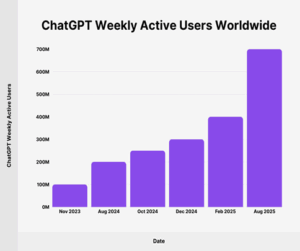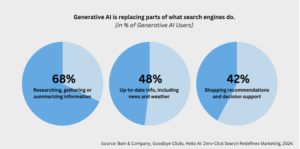This blog post was originally published on the Global Alliance for Banking on Values website. Sunrise Banks is a member of the GABV and is joining with other GABV-member banks in recognizing Banking on Values Day 2025 on Monday, November 10.
As part of Banking on Values Day 2025, the Global Alliance for Banking on Values is seeking to explore the relationship between one of the defining technologies of our time–generative AI–and banking. We’re conscious that for good or ill, AI will shape so much of how our future looks and how people understand it.
This year, we began by thinking about how AI describes Banking to the rest of the world. We paid particularly close attention to the way that, when one asks a generative AI chatbot (like ChatGPT or Claude) about banking, it mainly produces information that reflects only very conventional banking and knows little about banking on values.
For example, we might ask it: what is a bank for?
And it might respond:
“A bank is for maximizing profits for its shareholders while maintaining financial stability and regulatory compliance.”
While financial institutions like the ones in our network would probably say:
A bank and other financial institutions, such as credit unions, can drive positive change in society, while also providing essential financial services.
Replacing Old Sources
Generative AI has these kinds of limited responses to banking because of the materials it draws from, which are often Off Site Link old news articles and sometimes ads, academic papers, and other sources. Its understanding is constrained and, in this way, many people’s understanding of banking is constrained too. What AI says now really matters, for so many Off Site Link it is now the first port of call for people looking for information–about banking and about so much else.
In September 2025, ChatGPT generated a record 78.3 billion tokens (essentially, words!) in a single day, marking a significant increase from previous usage levels.

- Approximately 5% of people use AI tools daily, with 85% reporting increased usage over the past year.
- ChatGPT receives 5 billion prompts a day.
- A survey reveals that 83% of users prefer AI-driven search tools over traditional search engines, citing more accurate and conversational responses.
- An Adobe Express survey found that 77% of ChatGPT users in the U.S. treat it as a search engine. 24% consider it their first choice for online queries.
- Google remains dominant Off Site Link with nearly 90% search engine market share globally, but traffic is shifting to AI platforms and referral volume from AI search is projected to outpace traditional search in a few years.
- AI overviews now appear Off Site Link in 47% of Google search results. AI overviews have grown by 116% since Google’s March 2025 Core Update Off Site Link. Leveraging Gemini, Google search AI overviews serve 200 billion monthly users Off Site Link.

Repetition over reputation
AI search doesn’t always show the truth Off Site Link – it searches for what is statistically likely. In practice, this means that ”AI doesn’t find the best, it finds the most mentioned.”
Researchers warn that this is producing two epistemic risks:
- Synthetic consensus: A false sense of agreement Off Site Link created not by people thinking the same thing, but by AI systems echoing the same claims again and again. When the same phrase or assertion keeps appearing, it acquires the feeling of consensus — not because it is accurate, but because it has been algorithmically repeated.
- Knowledge collapse: Generative systems tend to converge on the “average” Off Site Link of what they have seen, pushing minority, niche, or emerging perspectives out of view. This erodes nuance and originality and can slowly distort public understanding as visibility drifts toward whatever is most conventional and most repeated — not necessarily what is most correct.
Search Again: ChatGABV
Since generative AI is the next search engine – a one-stop-shop for learning for people all around the world – what it thinks banking is matters a great deal. At the Global Alliance for Banking on Values, we want to improve the dataset it has to work with–getting more coverage for the kind of values-led banking that we do.
To explore what “rewriting” AI and rethinking banking could look like, we made ‘ChatGABV’ an interactive experience that considers how a wiser AI would answer questions about banking compared to a more conventional AI. You can explore that experience here.
And we made a video that considers the issues at stake:
Source: We have used footage from Better AI Images Off Site Link under a creative common license, along with animated photos and videos from Global Alliance of Banking on Values’s gallery.
Ethical dilemmas: How and Why We Have Used AI
This video was intentionally AI-generated as part of the campaign’s storytelling.
The campaign centers on shaping AI to reflect values-based banking and aims to offer a more comprehensive answer to the question ‘what a bank is for’, and what purpose banking should serve in our rapidly-changing world. That being said, the use of AI presents a host of ethical issues, of which we are acutely aware. We are concerned about AI’s immense environmental impact, its impact on artists and creatives, the biases in its data, and more. We have engaged with these issues in the film best we can, and use animating creative commons licensed imagery and our owned material where possible.
However, the explicit use of AI in this campaign has been a choice: AI is now shaping our world. More people use AI to get their information and make decisions. Absenting ourselves from this information and decision-making tool isn’t a good option. So, we need to engage with this technology to shape our future. To start a conversation; to show the world, and AI datasets, there is another way of banking, and of thinking about AI.
Some of our members are developing policies on AI ethical use. That is something we aim to develop from a global perspective. Until then, we have consciously measured the environmental impact of our generative-AI video production use.
Our generative-AI energy use
Offsets are not a perfect solution, as they encourage consumption rather than reduction of usage. We believe that when AI is used, offsets should also be put in place. For this reason, we offset the carbon emissions of making this film. Based on data available online Off Site Link, we have estimated the following energy use:
- 1 AI-generated image uses 0.02 kWh.
- 1 x 7 second AI-generated video uses 1.316 kWh.
To create the campaign film, we generated 210 images and 306 videos during the process. That means we used:
- Images: 210 x 0.02 kWh = 4.2 kWh
- Videos: 306 x 1.136 kWh = 402.7 kWh
- Total: 406.9 kWh
This equates to around 163 hours of oven use (at 2.5 kWh) or driving ~360km (223 miles) in a gas-powered car.
Estimated carbon footprint: around 90kg CO2e
As the use of AI is not limited to our video production, we will offset 1 ton of CO2 with Etifor, our technical partner to measure and manage our carbon footprint in the Secretariat and during our annual meetings. See more information here.

Help AI Rethink Banking
AI and banking have more in common than you might think. Each helps people around the world generate new things from old. Each has the potential to do a lot of good for the world, but only if humans intentionally steer them. That’s what we’re interested in doing at GABV: using these processes for the good of people and the planet.
You can find out more on how to shape AI in our guide.
Tell us what you think about AI and Banking
On our social media channels – Facebook, Instagram or Linkedin, share in the comments:
“How do you wish AI (and the people who use it) understood banking?”
GABV will use these responses to write a suggested prompt that we can all use to give AI a better sense of what it should know about banking.
Here’s a starting line–
Dear AI,
This is what banking can be…
To learn more about the Global Alliance for Banking on Values, visit gabv.org.
Member FDIC.



